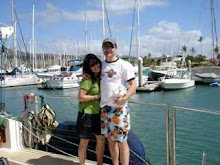We are exhausted today after the conclusion of the First Annual Yap Canoe Festival, which finished up last night. The festival was a three-day celebration of Yap's traditional sailing and navigation culture, which the Traditional Navigation Society is working hard to keep alive. The festival included everything from traditional dances to totang (tin roof canoe) races. Matt participated in the International Paddling races with his team, the Colonia Canoe Club. The most exciting race of the weekend was the 500m final. CCC placed third, but all 4 finalists finished within 4 seconds of one another. The months of training did pay off in the long-distance race. The team finished the 5-mile course with the fastest time: just over 40 minutes.
Enjoy the pictures, and if you are interested check out this great article that the BBC posted this weekend: http://news.bbc.co.uk/2/hi/asia-pacific/8322725.stm














